stop start Lexus GX470 2007 Instrument cluster / LEXUS 2007 GX470 OWNER'S MANUAL (OM60C64U)
[x] Cancel search | Manufacturer: LEXUS, Model Year: 2007, Model line: GX470, Model: Lexus GX470 2007Pages: 436, PDF Size: 11.52 MB
Page 60 of 436

40
1-3. Adjustable components
CAUTION
■Cross rail adjustment
Make sure the cross rails are locked securely by applying pressure forward and
rearward.
Failure to do so may cause an accident, deat h or serious injury in the event of emer-
gency braking or a collision.
■When loading cargo
Observe the following precautions:
●Place the cargo so that its weight is di stributed evenly between the front and rear
axles.
●If loading long or wide cargo, never exceed the vehicle overall length or width.
( P. 3 7 8 )
●Before driving, make sure the cargo is se curely fastened to the roof luggage car-
rier.
●Loading cargo on the roof luggage carrier will raise the vehicle’s center of gravity.
Avoid high speeds, sudden starts, sharp tu rns, sudden braking or abrupt maneu-
vers, otherwise unexpected loss of co ntrol or vehicle rollover may occur.
●If driving for a long distance, on rough ro ads, or at high speeds, stop the vehicle
occasionally during the trip to make su re the cargo remains securely fastened.
●Do not exceed 130 lb. (58 kg) cargo weight on the roof luggage carrier.
NOTICE
■When loading the luggage
Be careful not to scratch the surface of the moon roof.
■Cross rail stoppers
To prevent damage the moon roof, do not remove the cross rail stoppers.
Page 71 of 436
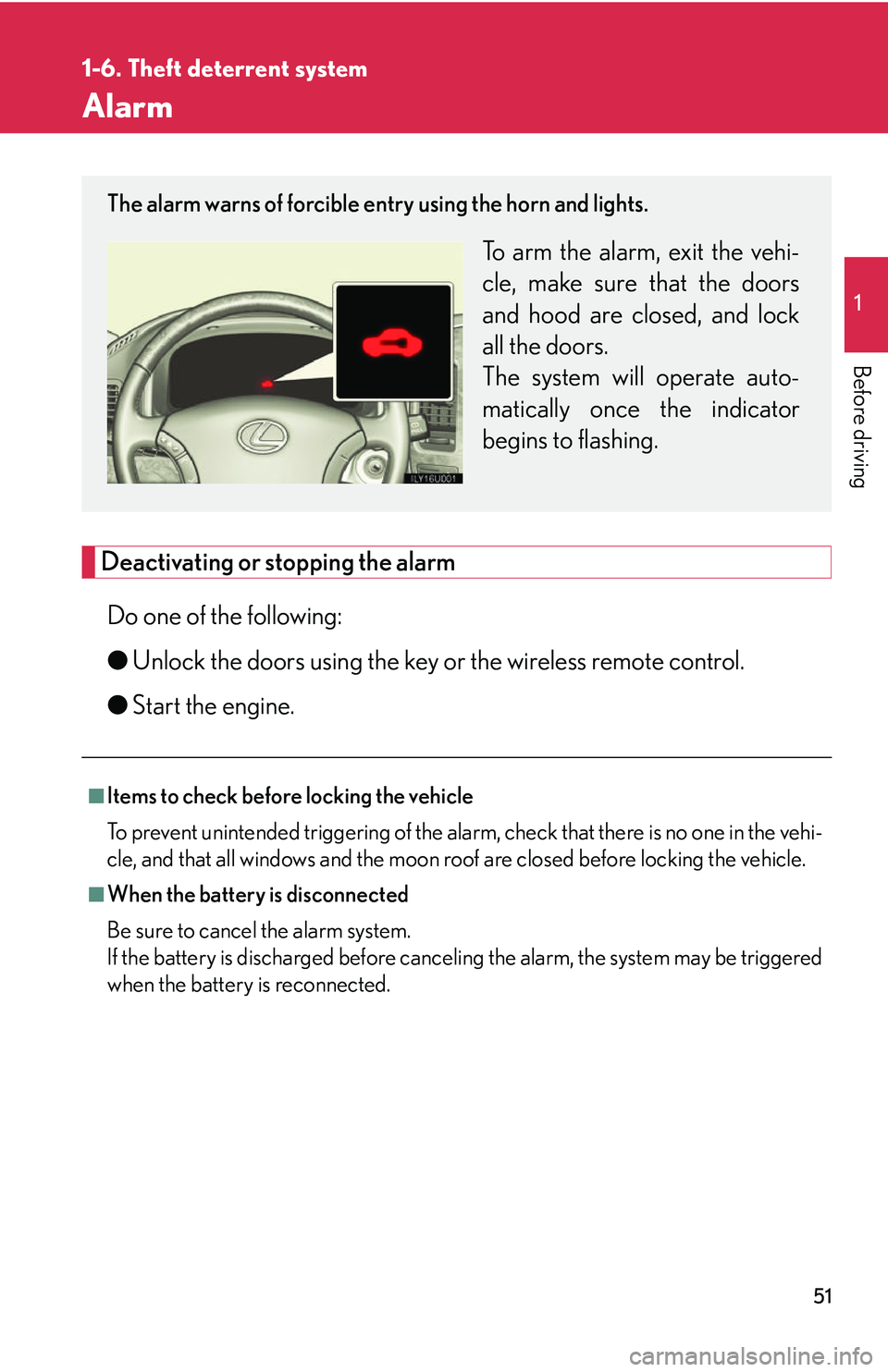
51
1
1-6. Theft deterrent system
Before driving
Alarm
Deactivating or stopping the alarmDo one of the following:
● Unlock the doors using the key or the wireless remote control.
● Start the engine.
■Items to check before locking the vehicle
To prevent unintended triggering of the alar m, check that there is no one in the vehi-
cle, and that all windows and the moon roof are closed before locking the vehicle.
■When the battery is disconnected
Be sure to cancel the alarm system.
If the battery is discharged before cancel ing the alarm, the system may be triggered
when the battery is reconnected.
The alarm warns of forcible entry using the horn and lights.
To arm the alarm, exit the vehi-
cle, make sure that the doors
and hood are closed, and lock
all the doors.
The system will operate auto-
matically once the indicator
begins to flashing.
Page 108 of 436
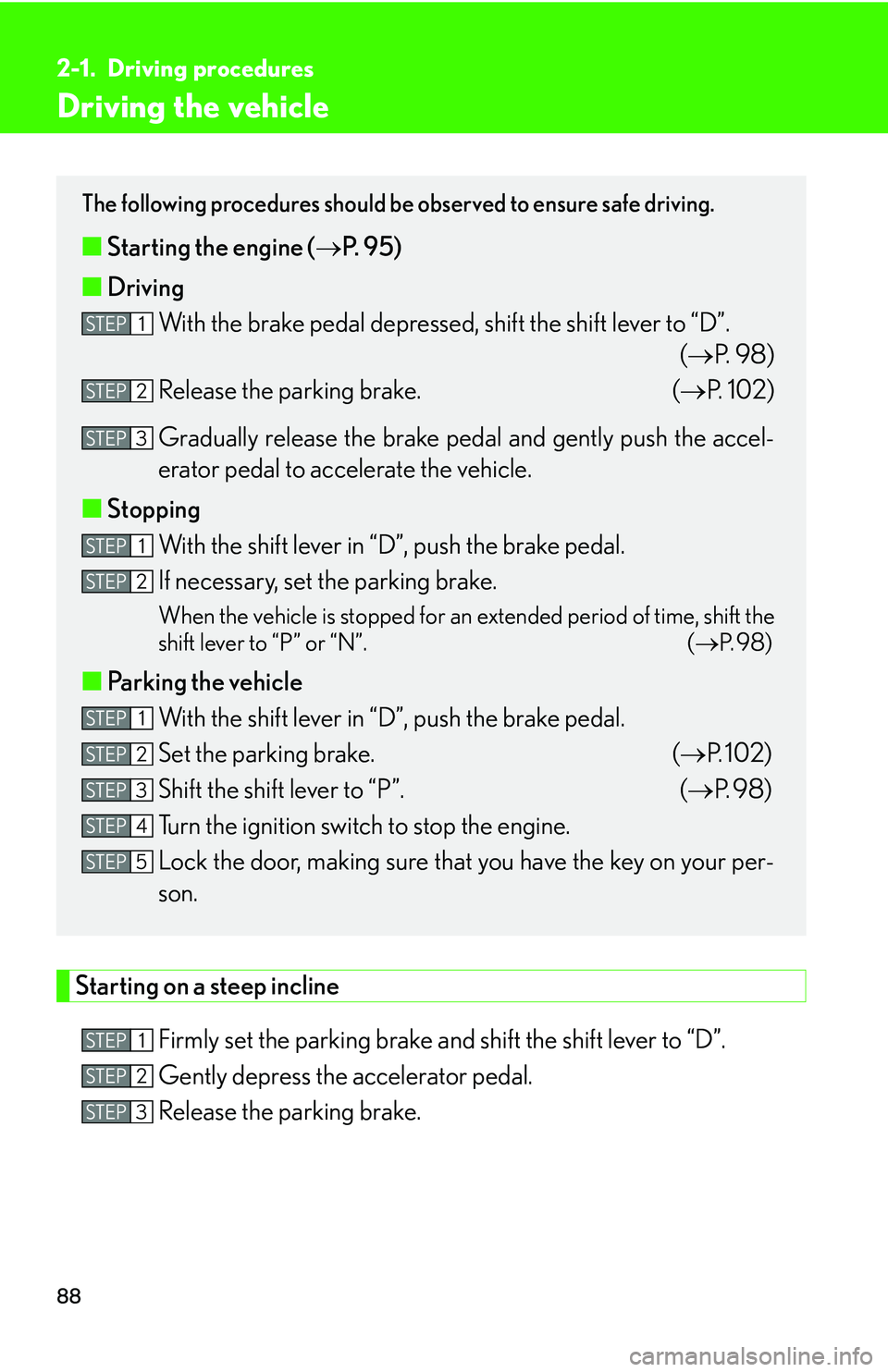
88
2-1. Driving procedures
Driving the vehicle
Starting on a steep inclineFirmly set the parking brake and shift the shift lever to “D”.
Gently depress the accelerator pedal.
Release the parking brake.
The following procedures should be observed to ensure safe driving.
■ Starting the engine ( P. 9 5 )
■ Driving
With the brake pedal depressed, shift the shift lever to “D”. (P. 9 8 )
Release the parking brake. ( P. 1 0 2 )
Gradually release the brake peda l and gently push the accel-
erator pedal to accelerate the vehicle.
■ Stopping
With the shift lever in “D”, push the brake pedal.
If necessary, set the parking brake.
When the vehicle is stopped for an extended period of time, shift the
shift lever to “P” or “N”. ( P. 9 8 )
■Parking the vehicle
With the shift lever in “D”, push the brake pedal.
Set the parking brake. ( P. 1 0 2 )
Shift the shift lever to “P”. ( P. 9 8 )
Turn the ignition switch to stop the engine.
Lock the door, making sure that you have the key on your per-
son.
STEP1
STEP2
STEP3
STEP1
STEP2
STEP1
STEP2
STEP3
STEP4
STEP5
STEP1
STEP2
STEP3
Page 110 of 436
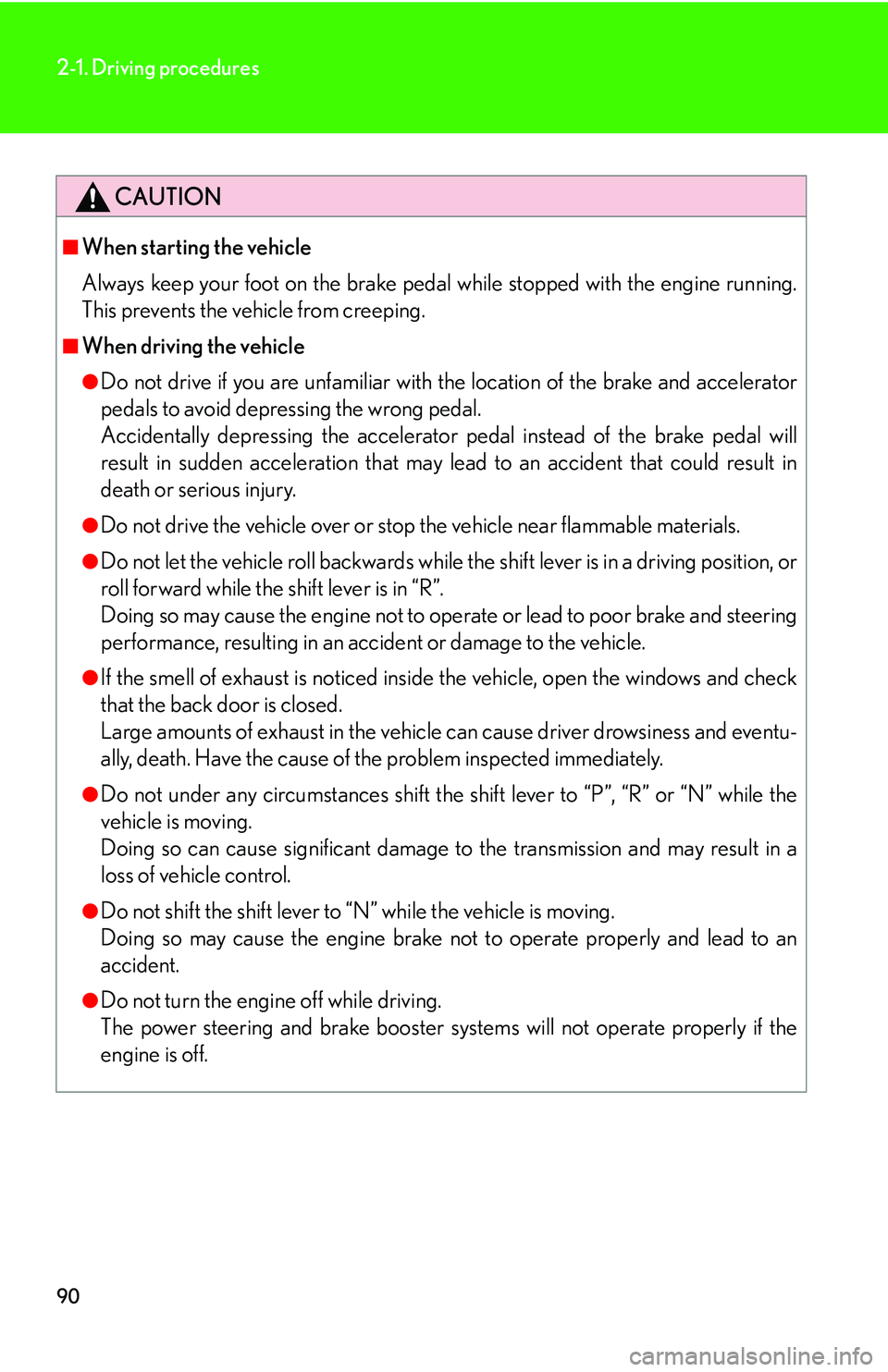
90
2-1. Driving procedures
CAUTION
■When starting the vehicle
Always keep your foot on the brake pedal while stopped with the engine running.
This prevents the vehicle from creeping.
■When driving the vehicle
●Do not drive if you are unfamiliar with the location of the brake and accelerator
pedals to avoid depressing the wrong pedal.
Accidentally depressing the accelerator pedal instead of the brake pedal will
result in sudden acceleration that may lead to an accident that could result in
death or serious injury.
●Do not drive the vehicle over or stop the vehicle near flammable materials.
●Do not let the vehicle roll backwards while the shift lever is in a driving position, or
roll forward while the shift lever is in “R”.
Doing so may cause the engine not to oper ate or lead to poor brake and steering
performance, resulting in an accident or damage to the vehicle.
●If the smell of exhaust is noticed inside the vehicle, open the windows and check
that the back door is closed.
Large amounts of exhaust in the vehicle can cause driver drowsiness and eventu-
ally, death. Have the cause of the problem inspected immediately.
●Do not under any circumstances shift the shift lever to “P”, “R” or “N” while the
vehicle is moving.
Doing so can cause significant damage to the transmission and may result in a
loss of vehicle control.
●Do not shift the shift lever to “N” while the vehicle is moving.
Doing so may cause the engine brake not to operate properly and lead to an
accident.
●Do not turn the engine off while driving.
The power steering and brake booster systems will not operate properly if the
engine is off.
Page 146 of 436

126
2-4. Using other driving systems
■If the vehicle height does not change
If the area around the rear suspension is coated with ice, or the undercarriage has
come into contact with the road surface, the rear height control suspension will not
operate. In this case, the indicator lights will change as follows:
●The current mode indicator light will turn off, and the target mode indicator light
will begin flashing.
●The target mode indicator light will turn off, and the original mode indicator light
will be lit once more. (The vehicle height does not change.)
If the rear height control air suspension cannot be operated even after removing
the ice or progressing to a smooth driving surface, turn off and restart the engine.
■ Parking and stopping tips
●If you immediately stop the engine after of f-road driving, or park the vehicle for
a long time, the vehicle height may gradually lower. When parking, make sure
there is nothing under the vehicle that may come in contact with the underbody.
The vehicle will return to the set height when the engine is started.
●The vehicle height may change as the temperature changes when the engine is
stopped. The vehicle will return to the set height when the engine is started.
■When lowering the vehicle
Even if the engine is stopped while the ve hicle height is being lowered, operation
will continue for up to 25 seconds. If any of the side doors or the back door is
opened within this 25 seconds, operatio n will continue for a further 15 seconds.
■ Rear height control failure warning
●If a malfunction occurs in the rear height control air suspension, normal mode is
automatically selected.
The height control “OFF” indicator will blink, and the vehicle height control can-
not be activated until the malfunction is corrected. Have the vehicle checked at
your Lexus dealer as soon as possible.
●If the height control “OFF” indicator li ght does not come on when the ignition
switch is turned to the “ON” position, there is a malfunction in the rear height
control air suspension. You can continue normal driving, however have the vehi-
cle checked by your Lexus dealer as soon as possible.
Page 148 of 436

128
2-4. Using other driving systems
NOTICE
■To avoid damage to the vehicle
●If in the low mode, the vehicle automatically shifts to the normal mode (vehicle
height is raised) when the engine is started. Take care when overhead height is
limited.
●After unloading, the vehicle height may be slightly higher than normal. Take care
when overhead height is limited.
●Before lowering the vehicle height, check that no-one is under the vehicle and
the area is free of obstructions. Also check that the underbody of the vehicle will
not touch the ground.
●Do not select the low mode when drivin g on bumpy roads, as the underbody of
the vehicle may contact the road surface.
■ Avoid rapid changes to the vehicle height when the vehicle is heavily loaded
As the compressor may overheat, causing the vehicle height adjustment operation
to stop.
Page 150 of 436

130
2-4. Using other driving systems
DAC (Downhill Assist Control system)
The DAC system helps to prevent excessive speed on steep downhill
slopes.
The system will operate when the vehicle is traveling under 15 mph
(25km/h) and the four wheel drive control lever is in the “L” position.
■System operation
Press the “DAC” switch. The
indicator will come on, and the
system will operate.
When the system is in operation,
the slip indicator light will flash,
and the stop lights/high
mounted stop lights will be lit.
■Turning off the system
Press the “DAC” switch while the system is in operation. The indica-
tor will flash as the system gradua lly ceases operation, and will turn
off when the system is fully off.
Press the “DAC” switch while the indicator is flashing to start the
system again.
Page 152 of 436
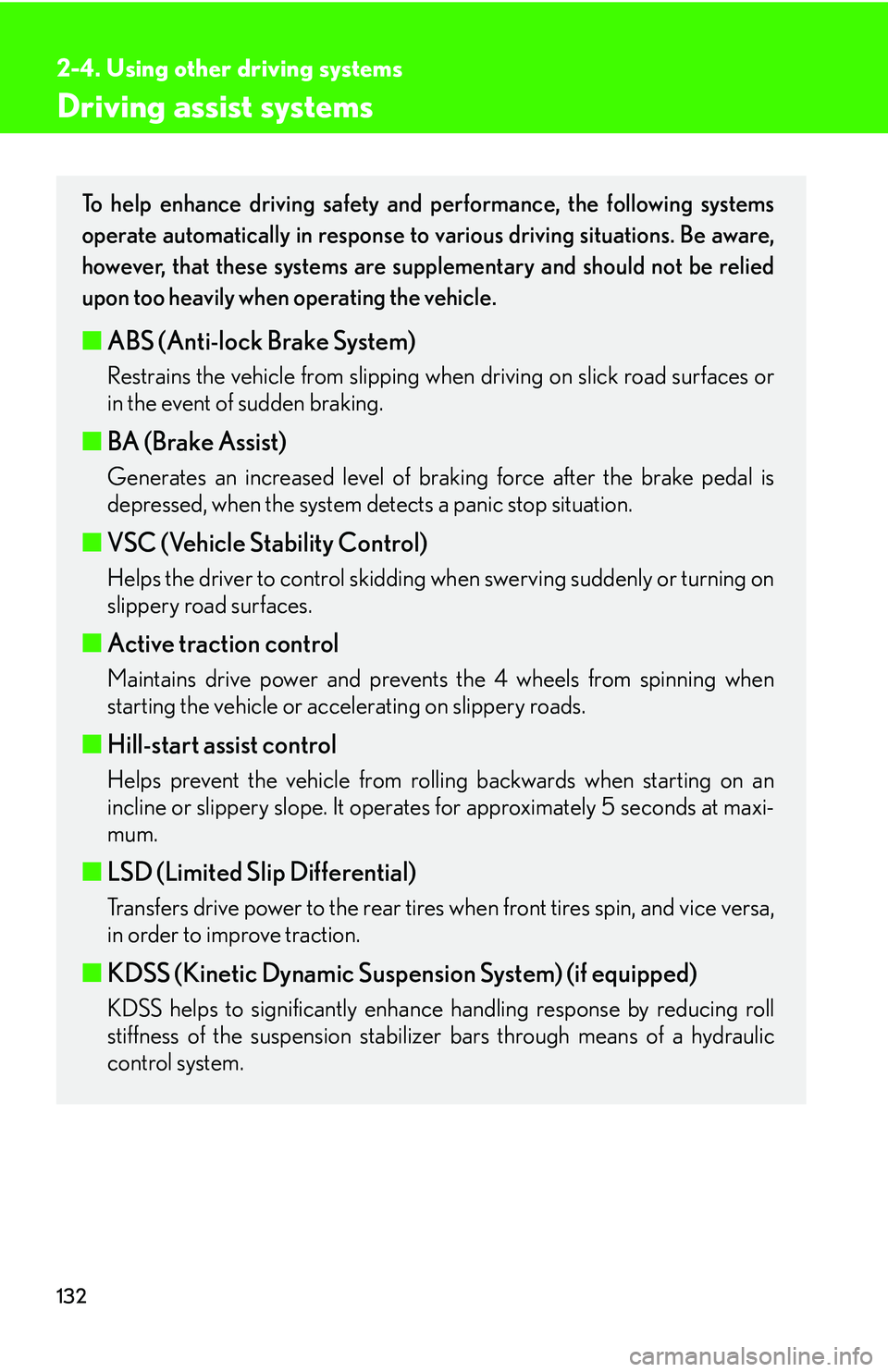
132
2-4. Using other driving systems
Driving assist systems
To help enhance driving safety and performance, the following systems
operate automatically in response to various driving situations. Be aware,
however, that these systems are supplementary and should not be relied
upon too heavily when operating the vehicle.
■ABS (Anti-lock Brake System)
Restrains the vehicle from slipping when driving on slick road surfaces or
in the event of sudden braking.
■BA (Brake Assist)
Generates an increased level of braking force after the brake pedal is
depressed, when the system detects a panic stop situation.
■VSC (Vehicle Stability Control)
Helps the driver to control skidding when swerving suddenly or turning on
slippery road surfaces.
■ Active traction control
Maintains drive power and prevents the 4 wheels from spinning when
starting the vehicle or accelerating on slippery roads.
■Hill-start assist control
Helps prevent the vehicle from rolling backwards when starting on an
incline or slippery slope. It operates for approximately 5 seconds at maxi-
mum.
■ LSD (Limited Slip Differential)
Transfers drive power to the rear tires when front tires spin, and vice versa,
in order to improve traction.
■KDSS (Kinetic Dynamic Suspension System) (if equipped)
KDSS helps to significantly enhance handling response by reducing roll
stiffness of the suspension stabilizer bars through means of a hydraulic
control system.
Page 153 of 436
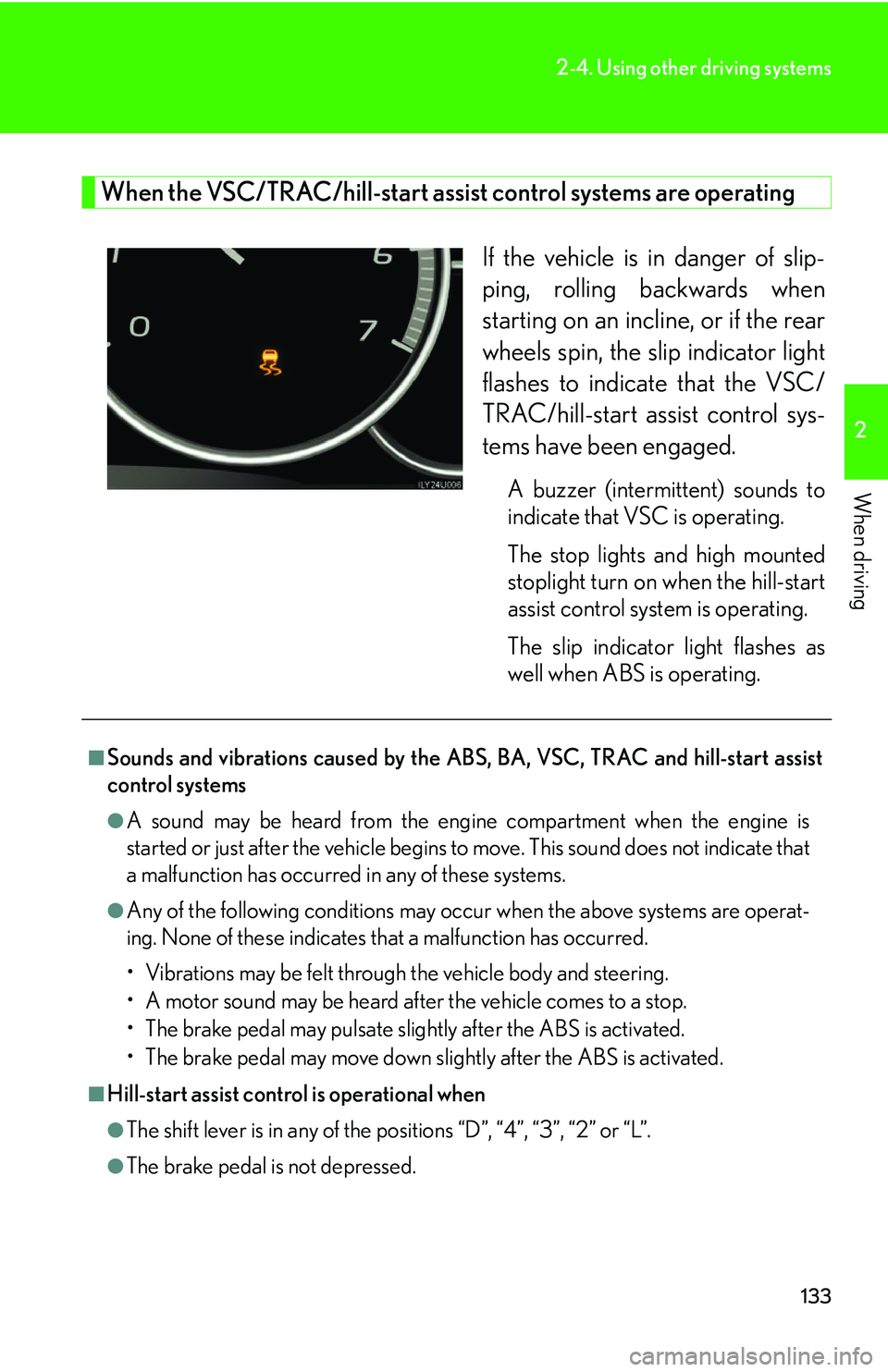
133
2-4. Using other driving systems
2
When driving
When the VSC/TRAC/hill-start assist control systems are operating
If the vehicle is in danger of slip-
ping, rolling backwards when
starting on an incline, or if the rear
wheels spin, the slip indicator light
flashes to indicate that the VSC/
TRAC/hill-start assist control sys-
tems have been engaged.
A buzzer (intermittent) sounds to
indicate that VSC is operating.
The stop lights and high mounted
stoplight turn on when the hill-start
assist control system is operating.
The slip indicator light flashes as
well when ABS is operating.
■Sounds and vibrations caused by the ABS, BA, VSC, TRAC and hill-start assist
control systems
●A sound may be heard from the engi ne compartment when the engine is
started or just after the vehicle begins to move. This sound does not indicate that
a malfunction has occurred in any of these systems.
●Any of the following conditions may occur when the above systems are operat-
ing. None of these indicates that a malfunction has occurred.
• Vibrations may be felt through the vehicle body and steering.
• A motor sound may be heard after the vehicle comes to a stop.
• The brake pedal may pulsate slightly after the ABS is activated.
• The brake pedal may move down s lightly after the ABS is activated.
■Hill-start assist control is operational when
●The shift lever is in any of the positions “D”, “4”, “3”, “2” or “L”.
●The brake pedal is not depressed.
Page 154 of 436
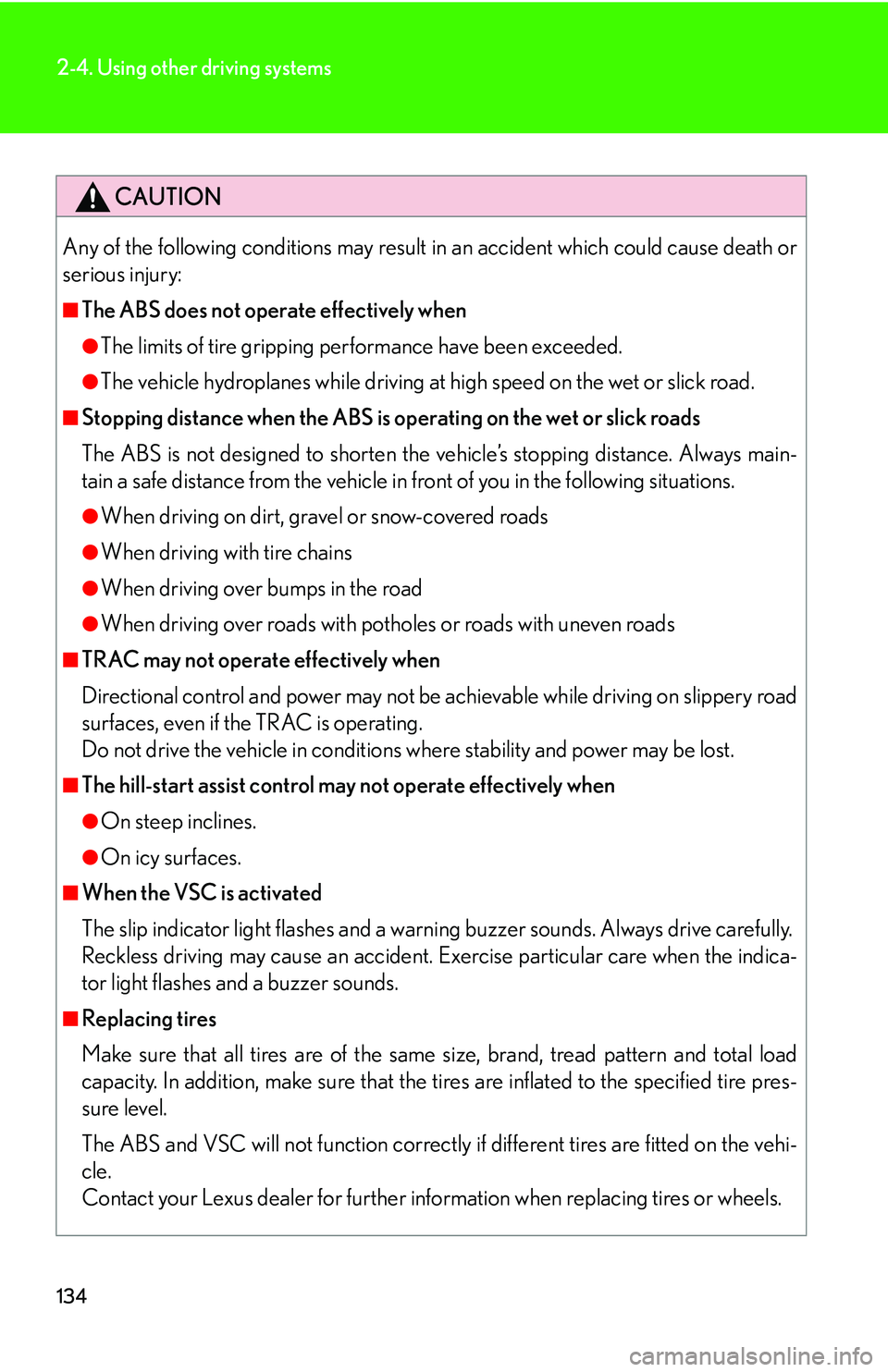
134
2-4. Using other driving systems
CAUTION
Any of the following conditions may result in an accident which could cause death or
serious injury:
■The ABS does not operate effectively when
●The limits of tire gripping performance have been exceeded.
●The vehicle hydroplanes while driving at high speed on the wet or slick road.
■Stopping distance when the ABS is operating on the wet or slick roads
The ABS is not designed to shorten the vehicle’s stopping dist ance. Always main-
tain a safe distance from the vehicle in front of you in the following situations.
●When driving on dirt, gravel or snow-covered roads
●When driving with tire chains
●When driving over bumps in the road
●When driving over roads with potholes or roads with uneven roads
■TRAC may not operate effectively when
Directional control and power may not be ac hievable while driving on slippery road
surfaces, even if the TRAC is operating.
Do not drive the vehicle in conditions where stability and power may be lost.
■The hill-start assist control may not operate effectively when
●On steep inclines.
●On icy surfaces.
■When the VSC is activated
The slip indicator light flashes and a warning buzzer sounds. Always drive carefully.
Reckless driving may cause an accident. Exercise particular care when the indica-
tor light flashes and a buzzer sounds.
■Replacing tires
Make sure that all tires are of the same size, brand, tread pattern and total load
capacity. In addition, make sure that the ti res are inflated to the specified tire pres-
sure level.
The ABS and VSC will not function correctly if different tires are fitted on the vehi-
cle.
Contact your Lexus dealer for further info rmation when replacing tires or wheels.